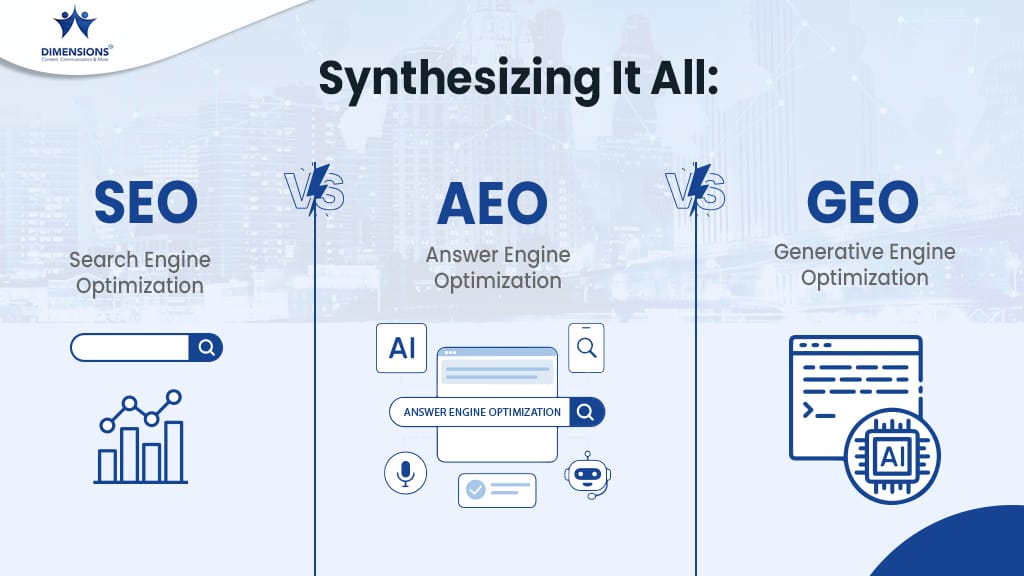SEO, AEO and GEO Strategies: The Complete Guide to Maximising Online Visibility

Meta Description – The web is rapidly changing, with snippets and AI replacing traditional search. A business now needs to master SEO, AEO and GEO to thrive. Learn how to go about it.
The digital landscape is continuously being transformed by emerging changes in customer behaviour and technological innovations. In the past few years, the rise of Artificial Intelligence (AI) has brought about a paradigm shift that has changed how we engage with data and, therefore, how brands need to communicate online.
No longer is simply appearing in a search sufficient. The new meta calls for accuracy, straight answers, and a better comprehension of the inner workings of AI. This has led to a triumvirate of optimisation practices: SEO (Search Engine Optimisation), AEO (Answer Engine Optimisation), and GEO (Generative Engine Optimisation).
Though differing in scope, these three pillars are interrelated, forming the foundation of a robust online presence strategy for the AI era. Here in this blog, we will explore each in complete detail, as well as some practical strategies for you to leverage these ideas to build your business.
Search Engine Optimisation (SEO)
SEO, in its essence, is the central strategy of online visibility. It’s the art and science of having your website noticed when customers search for your company’s products or services on traditional search engines such as Google and Bing. The concept is to be higher in organic (free) search engine results, directing traffic to your site.
Prior to the AI days, SEO was highly keyword, backlink, and technical-based, such as speed and mobile-friendliness. Although they are not irrelevant today, there has been a major overhaul of SEO since the advent of AI. Search engines, thanks to new technology and Natural Language Processing (NLP), now favour:
- User Intent and Semantic Search: Modern SEO is about more than just keyword matching. AI enables search engines to realise what the real purpose behind the search query and semantic intent of material is. Optimisation for topics and full answers which actually cater to user intent, rather than keyword stuffing, is the result.
- Depth and Content Quality: AI prefers valuable, interesting, high-quality content that demonstrates expertise, experience, authoritativeness, and trustworthiness (E-E-A-T). Content that gives real value, gives thorough answers, and is thoroughly researched works best.
- User Experience (UX): Page speed, mobile responsiveness, ease of navigation, and user experience are more important than ever. Google’s Core Web Vitals, for example, point to the value placed on a fast, visually stable user experience, which has direct bearing on rankings.
- Multimodal Search: As image search, voice search, and video came onto the scene, text is no longer the exclusive domain of SEO. Image, video, and audio searchability come into play as well.
- Technical SEO for AI Crawlers: AI also requires good content to comprehend and process quickly. Good markup, clean coding, and site structure allow AI models to crawl, index, and comprehend your content easily.Essentially, classic SEO today is all about developing a technically correct website with quality and user-focused content that resonates with human search intent alongside AI interpretability. You have to build a robust and reliable web presence that search engines, and hence AI, will be able to trust.
Answer Engine Optimisation (AEO)
With the advent of voice assistants like Alexa, Google Assistant, and Siri, and the increasing prominence of featured snippets and knowledge panels in search results, Answer Engine Optimisation (AEO) was born. AEO is the act of optimising your content so that search engines can provide answers directly to a user’s question without the user having to click through to a site.
AEO engages in “zero-click searches,” in which users find their answers instantly. This is especially common for:
- Voice Search: Individuals with voice commands will generally need rapid, short answers to encourage questions.
- Featured Snippets: These are the boxed answers displayed directly at the top of Google search results, answering the question flat out.
- Knowledge Panels: These right-hand side information boxes on Google search results summarise facts about a person, place, company, or thing.
The building blocks to successful AEO are:
- Understanding User Questions: Get inside your audience’s head. What specific questions are they having about your products, services, or company?
- Clean Q&A Formatting: Organise your content in easy-to-read headings (H1, H2, H3) that are a question followed by a speedy answer in brief, direct language. FAQs sections work especially well.
- Structured Data: Using schema markup (e.g., FAQ schema, HowTo schema) enables search engines to understand context and intent behind your content, and makes it simpler for them to identify direct answers.
- Conciseness and Clarity: Brevity and simplicity are what AEO likes. Responses should be short, clear, and free of jargon.
- Authority and Trust: Like SEO, how authoritative and trusted your website and content are will be the most important factor. Search engines prefer to take answers from authoritative and trusted sources.
AEO is all about becoming the default provider of a certain response. Even if the user never click-throughs, your brand gets seen and builds trust and rememberability for repeat interactions.
Generative Engine Optimisation (GEO)
Large language models (LLMs) such as ChatGPT, Google’s Gemini, and AI Summaries of search are the latest search revolution. This has created a new concept of Generative Engine Optimisation (GEO), which is a strategy to make your content easily understandable and part of the answers generated by these AI entities.
As opposed to classical SEO, trying to win clicks, or AEO, trying to give straight answers, GEO tries to get your content mentioned or quoted as a trusted source in an AI-generated summary or dialogue. This means leveraging the manner that AI models organise information and display it to users.
Some of the most critical things about GEO are:
- AI Content Consumption: It’s all about writing content which is well structured, factual, and palatable for LLMs. Structure your thoughts in the style of short statements, bullet points, numbered lists, and tables of information that list things out.
- Displaying Authority and Trustworthiness: AI models love authoritative sources. Your own content being E-E-A-T compliant now more than ever before is incredibly important. This includes citing respectable sources within your own content.
- AI Query Forecasting: Just like with human search, it is essential to be aware of what questions would be posed to AI applications by users. Make your content a better source of responses to such questions so that it can serve as an effective tool for generative AI.
- Factuality and Precision: The goal of AI models is to deliver accurate facts. Factual content that is verifiable will stand a greater chance of being taken up as a reference.
- Steering Clear of Ambiguity and Nuance: Human language loves nuance, but AI systems tend to favuor clear, unambiguous language. Structure your content as clearly as possible when presenting important information.
- Monitoring AI Cites: As more and more content is created by AI, it will become ever more critical to track where and in what way your content is being cited by AI algorithms as an important measure of GEO success.
GEO ensures that whenever someone queries an AI algorithm about your brand, your content is one of the first and most authoritative sources that it points to.
Synthesizing It All: SEO + AEO + GEO
It’s also worth mentioning that SEO, AEO, and GEO don’t necessarily exclude each other. Rather, they’re complementary tactics that, in aggregate, constitute an integrated system for online presence.
- SEO is the Groundwork: Good SEO makes your content crawled by search engines initially. Without that, your content will never even be in consideration for AEO or GEO. Technical SEO, keyword research, and proper backlink groundwork are still the building blocks of creating authority and crawlability.
- AEO Refined for Direct Answers: Building on a solid SEO foundation, AEO optimises specific content for direct answers, catering to the growing trend of zero-click searches and voice interactions.
- GEO Future-Proofs for AI: GEO extends optimisation to the realm of generative AI, ensuring your brand’s expertise is recognised and leveraged by LLMs. It ensures you’re part of the AI-driven conversation and a cited source of facts.
Consider it in layers:
- Layer 1 (SEO): Your site is technically perfect, crawlable, and your content is well-indexed and ranked for the right topics and keywords, directing traffic to your site.
- Layer 2 (AEO): Certain well-relevant blocks of content on your site are optimised to be displayed as featured snippets or power answers through voice assistants, giving users instant answers.
- Layer 3 (GEO): Your authoritative, in-depth content is accepted by generative AI models as a valid source, and your brand becomes cited or abstracted in AI-produced summaries and answers, increasing your credibility and indirect visibility.
Practical Steps for Mastering the AI Revolution for your Business
If your brands want to crack the code and get the most out of SEO, AEO, and GEO, then the following actionable steps are recommended:
- Do thorough audience analysis: Besides keywords, know what questions your audience ask, their challenges, and how they word their questions (typed and verbal).
- Prioritise E-E-A-T Across All Content: Set your brand as an authority, show real-world experience in a legitimate way, develop authority with credible sources and backlinks, and maintain trustworthiness with transparent and accurate content.
- Structure Content for Clarity and AI Digestibility: Use clear, concise headings (H1, H2, H3) that are questions or absolute statements. Break down in-depth subjects into bite-sized pieces using bullet points, numbered lists, and tables. Have a distinct FAQ section with short answers.
- Adopt Multimodal Content: Produce and optimise video, audio, and image content, as AI further processes content in multiple modes.
- Prioritise Semantic Density: Write for topics, and the interconnectivity of ideas rather than keywords.
- Update and Refresh Content Regularly: AI algorithms like fresh, current information.
- Monitor AI-Generated Results: Monitor how AI summaries and chatbots summarise material on your space and competitors. Identify opportunities to improve your content for increased AI inclusion.
- Adapt to Changes in AI Algorithms: The AI meta is always evolving. Stay abreast of changes in search algorithms and AI models.
By starting with high-quality, human-focused content, using structured data, and knowing how humans and AI both ingest information, your company can make your brand not only findable but also the go-to solution and the go-to source in a smarter-by-the-day digital world. The future of online visibility will be dominated by those who master this triple strategy. Contact us today, to find out how you can be on the right side of the new internet.





